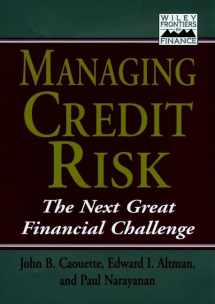
Managing Credit Risk: The Next Great Financial Challenge (Frontiers in Finance Series)
Book details
Summary
Description
The first full analysis of the latest advances in managing credit risk.
"Against a backdrop of radical industry evolution, the authors of Managing Credit Risk: The Next Great Financial Challenge provide a concise and practical overview of these dramatic market and technical developments in a book which is destined to become a standard reference in the field." -Thomas C. Wilson, Partner, McKinsey & Company, Inc.
"Managing Credit Risk is an outstanding intellectual achievement. The authors have provided investors a comprehensive view of the state of credit analysis at the end of the millennium." -Martin S. Fridson, Financial Analysts Journal.
"This book provides a comprehensive review of credit risk management that should be compulsory reading for not only those who are responsible for such risk but also for financial analysts and investors. An important addition to a significant but neglected subject." -B.J. Ranson, Senior Vice-President, Portfolio Management, Bank of Montreal.
The phenomenal growth of the credit markets has spawned a powerful array of new instruments for managing credit risk, but until now there has been no single source of information and commentary on them. In Managing Credit Risk, three highly regarded professionals in the field have-for the first time-gathered state-of-the-art information on the tools, techniques, and vehicles available today for managing credit risk. Throughout the book they emphasize the actual practice of managing credit risk, and draw on the experience of leading experts who have successfully implemented credit risk solutions.
Starting with a lucid analysis of recent sweeping changes in the U.S. and global financial markets, this comprehensive resource documents the credit explosion and its remarkable opportunities-as well as its potentially devastating dangers. Analyzing the problems that have occurred during its growth period-S&L failures, business failures, bond and loan defaults, derivatives debacles-and the solutions that have enabled the credit market to continue expanding, Managing Credit Risk examines the major players and institutional settings for credit risk, including banks, insurance companies, pension funds, exchanges, clearinghouses, and rating agencies. By carefully delineating the different perspectives of each of these groups with respect to credit risk, this unique resource offers a comprehensive guide to the rapidly changing marketplace for credit products.
Managing Credit Risk describes all the major credit risk management tools with regard to their strengths and weaknesses, their fitness to specific financial situations, and their effectiveness. The instruments covered in each of these detailed sections include: credit risk models based on accounting data and market values; models based on stock price; consumer finance models; models for small business; models for real estate, emerging market corporations, and financial institutions; country risk models; and more. There is an important analysis of default results on corporate bonds and loans, and credit rating migration. In all cases, the authors emphasize that success will go to those firms that employ the right tools and create the right kind of risk culture within their organizations. A strong concluding chapter integrates emerging trends in the financial markets with the new methods in the context of the overall credit environment.
Concise, authoritative, and lucidly written, Managing Credit Risk is essential reading for bankers, regulators, and financial market professionals who face the great new challenges-and promising rewards-of credit risk management.


We would LOVE it if you could help us and other readers by reviewing the book
Book review



